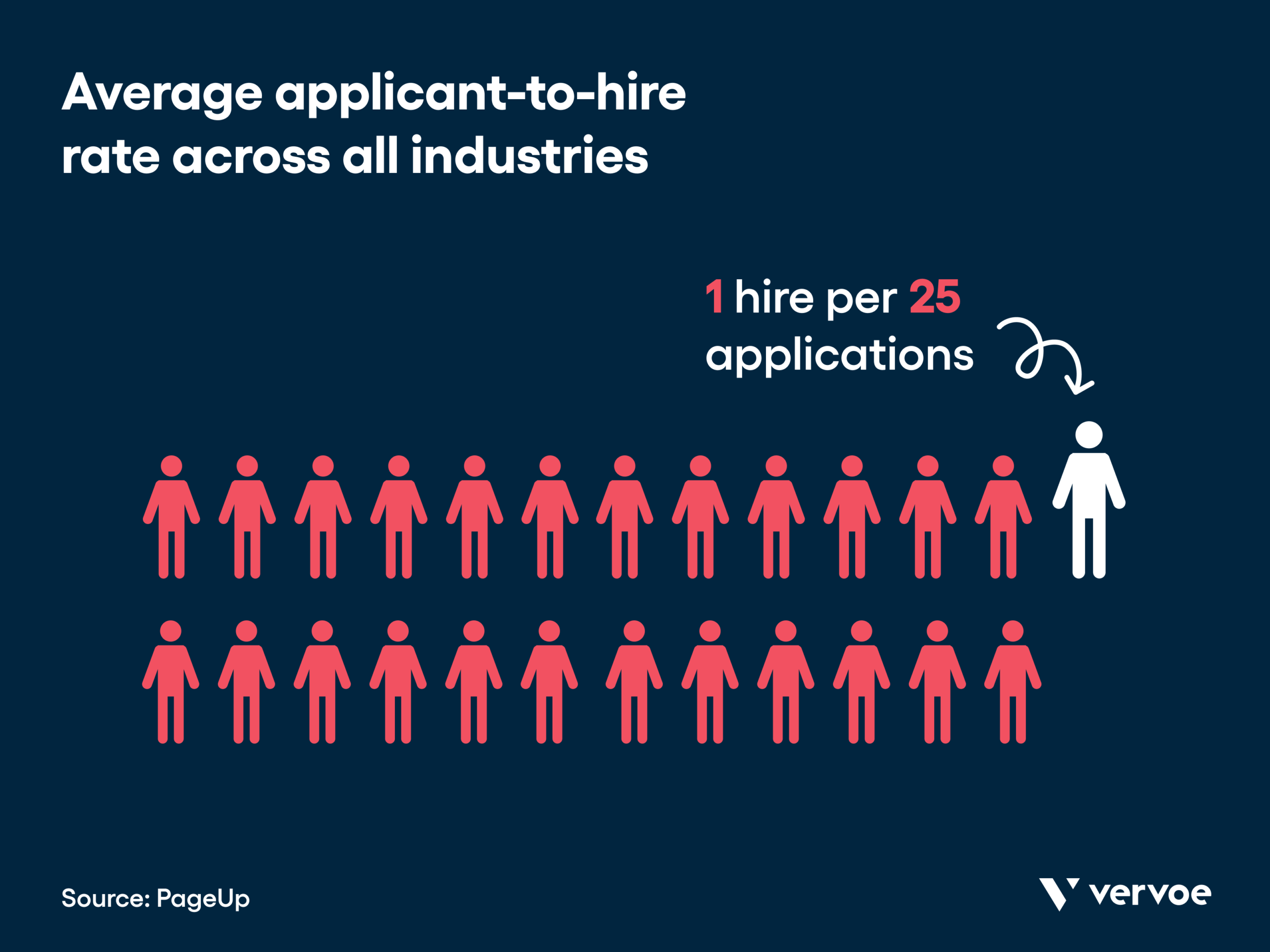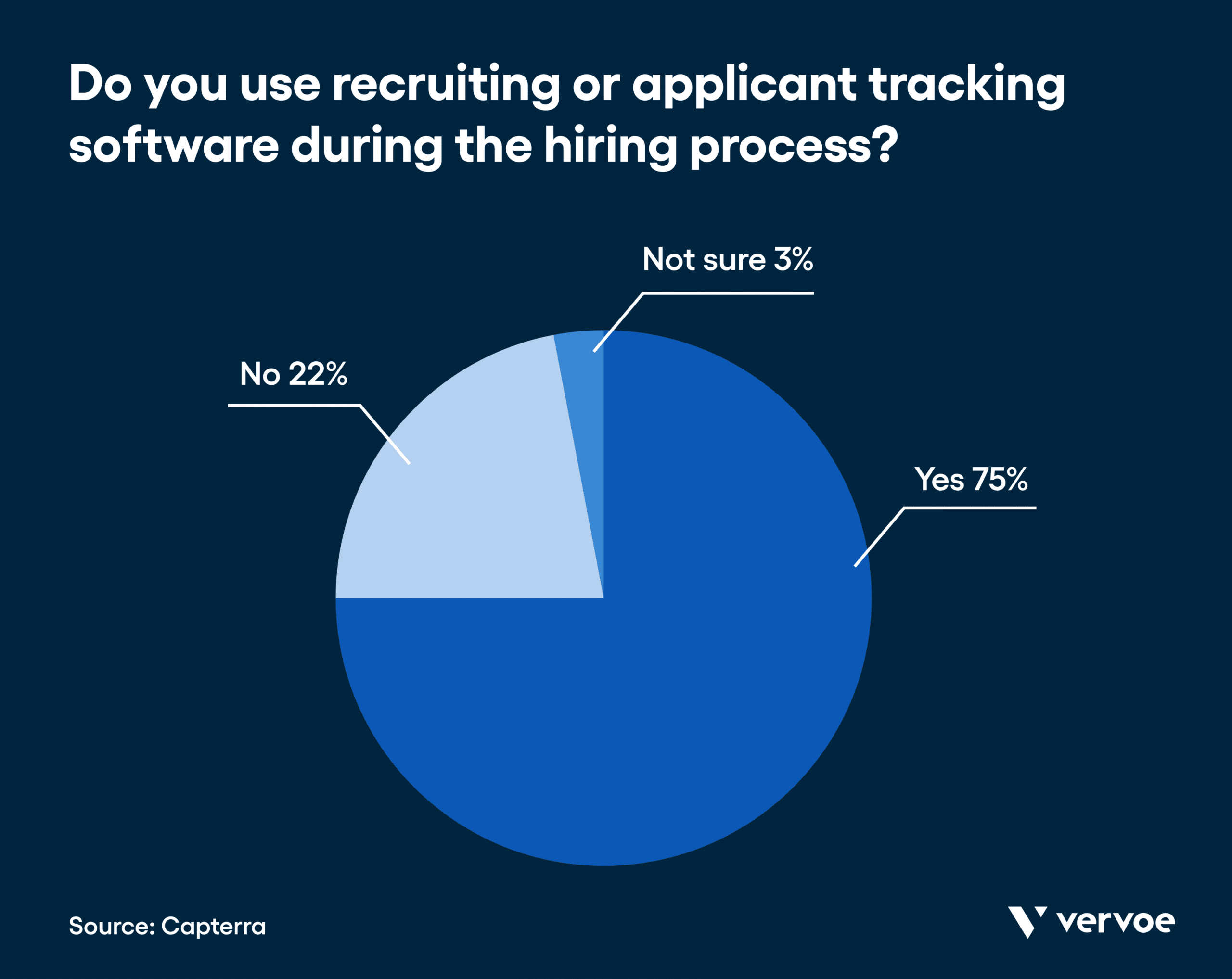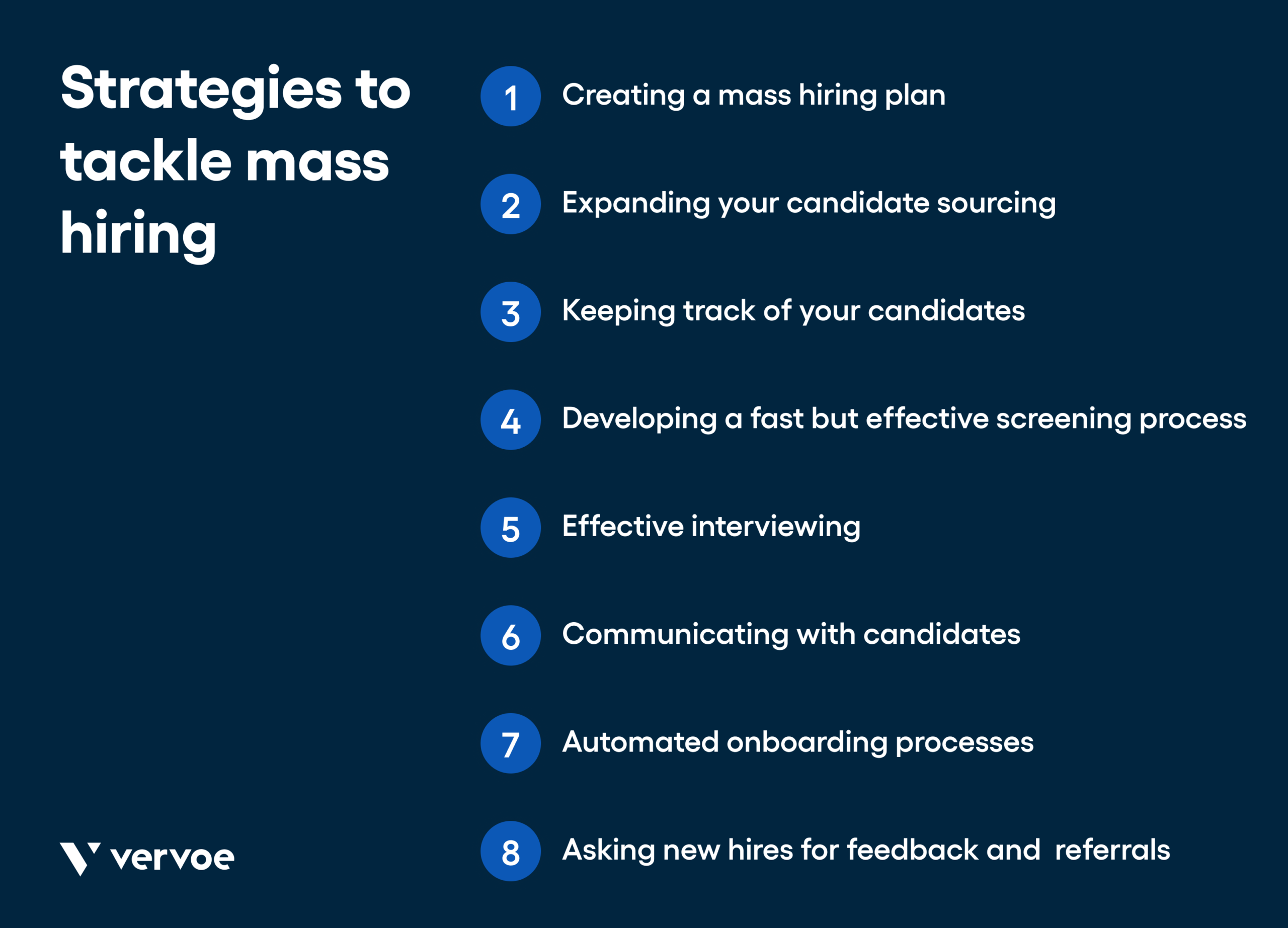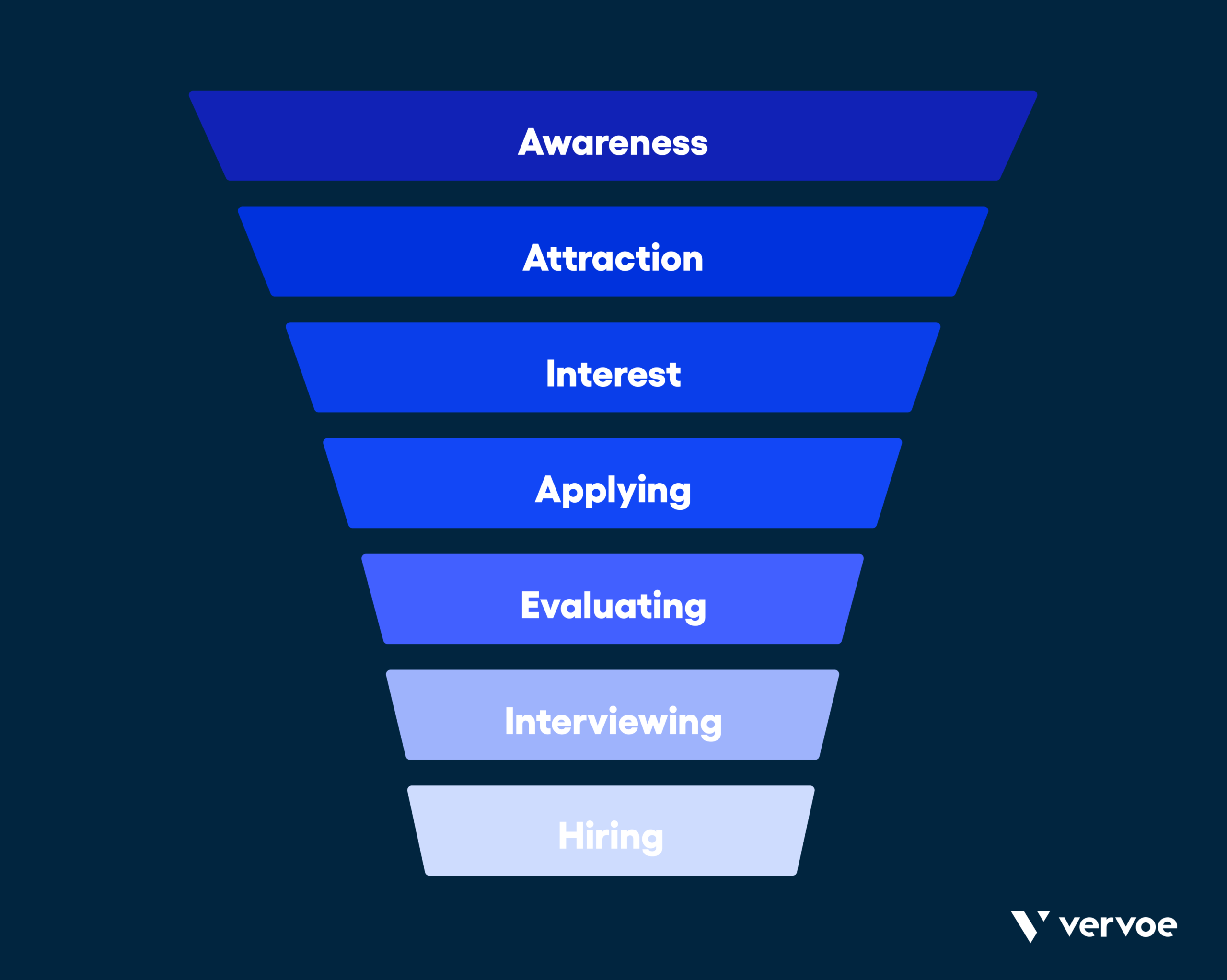It’s Monday morning, and the whole team has gathered together in expectation of a major announcement. The CEO walks in, clears their throat, and tells everyone that the company will open up a second branch at the start of the new year. It’s exciting news and demonstrates that the business is in fantastic shape and growing rapidly.
But the head of recruitment turns pale. They know that the new branch will require the hiring of hundreds of new workers in a very short timeframe and that the CEO will not accept any sort of compromise in terms of quality of hire. They realize the existing, manual recruitment processes will be totally inadequate in a high-volume situation.
With a sigh, they open Google and type: “Mass hiring”.
Mass hiring definition
Mass hiring or bulk hiring is the recruitment of a large number of people in a compressed time frame. The technique is often used when a company is growing fast, or in a situation (such as opening a new branch) where many new employees are required at once.
Mass hiring requires a higher focus on hiring velocity, automation, and efficiency than low-volume hiring, particularly in terms of eliminating manual processes that become untenable at scale. Every part of your recruitment process needs to be reviewed, including candidate screening, communication, interviewing, and onboarding.
Challenges of mass hiring
Without careful planning and management, mass hiring can come with two potential downsides:
- A drop in quality of hire, and
- A suboptimal candidate experience.
Both of these challenges are linked to the fact that talent acquisition professionals are forced to take more of a hands-off approach than they would in a low-volume situation.
Luckily, recruitment software and process automation have advanced to the point where these challenges can be overcome. Process automation is also key to achieving mass hiring targets within challenging timelines.
Strategies to tackle bulk hiring
Below, we’ll share the following strategies for getting the best results out of your mass hiring process:
- Creating a mass hiring plan
- Expanding your candidate sourcing
- Keeping track of your candidates
- Developing a fast but effective screening process
- Effective interviewing
- Communicating with candidates
- Automated onboarding processes
- Asking new hires for feedback and referrals
1. Creating a mass hiring plan
In the scenario above, the head of recruitment was caught unprepared by the CEO’s announcement of a new branch. Even if your organization appears unlikely to experience rapid expansion anytime soon, it pays to have a mass hiring plan ready to go if (or when) things take off.
When creating your mass hiring plan, break down the plan into sub-tasks related to your recruitment funnel. To recap, most recruitment funnels include seven key parts:
- Awareness
- Attraction
- Interest
- Applying
- Evaluating
- Interviewing
- Hiring
Consider every part of your recruitment funnel in terms of its ability to process a high volume of candidates at speed. Where are bottlenecks likely to occur? Which parts of your funnel currently require manual (human) intervention? What will need to be changed or improved? What can be fast-tracked, and what can potentially be skipped?
Here’s the good news: any efficiency improvements that you make to your recruitment process in preparation for mass hiring also have the potential to benefit your usual, low-volume hiring processes.
2. Expanding your candidate sourcing
There’s little use in setting up a kick-ass mass hiring process if you don’t have enough candidates coming through the funnel. Therefore, expanding your sources for bulk hiring is crucial. Consider the following strategies to rapidly grow your candidate pool:
- Hire temporary additions to your talent team to focus on candidate sourcing.
- Outsource candidate sourcing to multiple (trusted) recruitment agencies.
- Expand the number and variety of places where you post your job ads, but ensure they are targeted to attract relevant candidates.
- Ramp up your social media recruitment campaign so more people see your job ads. Consider sponsoring posts.
- Launch a bounty program to encourage your current staff to refer potential candidates.
Remember, it isn’t enough to simply get more eyes on your job ads. Your employee value proposition must be powerful enough to motivate candidates to hit the apply button.
[Read more: How To Attract, Hire and Retain Remote Employees]
How many applicants do you need?
According to PageUp, the average applicant-to-hire rate across all industries globally is 1 hire per 25 applications. While this sounds manageable in low-volume hiring situations, the numbers quickly become a bit scary when we think about mass hiring – if you need to hire 200 workers, you may need to process 5000 applications.

3. Keeping track of your candidates
In the pre-digital age, talent acquisition professionals’ desks groaned under teetering piles of manila folders, each stuffed with paperwork including applicants’ résumés, photocopies of credentials, and more. Excel spreadsheets helped but were still a nightmare to manage.
Today, 75% of hiring professionals use Applicant Tracking Systems (ATS). These databases are an essential bulk-hiring tool and keep track of candidates by automating the job application process, capturing candidates’ data, storing and parsing their résumés, automating communication, and helping users discover at the touch of a button where a candidate currently is in the recruitment funnel.

Take care when automating
Automation is essential in a bulk-hiring environment, but take care – a poorly planned automated recruitment process can create a terrible candidate experience. ATS systems can cause candidate pain through lengthy or hard-to-use job applications, inadequate and impersonal automated communication, and generally treat candidates like numbers, not human beings. This can be addressed by ensuring all candidate communications are warm, friendly, and personalized (even when fully automated), and having an uncompromising focus on UX when creating your process.
If you choose to use an ATS as a bulk-hiring strategy, be aware that the technology is notorious for rejecting applications for technical reasons. Studies have shown that up to 75% of qualified applicants are rejected because their documents can’t be read by ATS programs, often due to minor formatting differences. In a mass hiring situation where you need as many applicants coming through the funnel as possible, this is a technical bug you simply cannot afford.
4. Developing a fast but effective screening process
Screen fast, screen efficiently, and (most importantly) screen early.
Résumé screening
Automated résumé screening may be fast, but there’s plenty of evidence to suggest it isn’t effective. Résumés are a snapshot of academic credentials and work experience, neither of which necessarily predict future job success. Added to this, candidates lie on their résumés. Automated résumé screening relies on scanning for keywords, which means that the simple omission of a single word or phrase can cause a hidden gem to be screened out. Finally, résumés contain personal information (names, location, gender) that contribute to hiring bias, even in an apparently objective ATS program.
Skills assessments
A better way to screen applicants in a volume hiring situation is through the use of automated skills assessments. Ideally, your procurement process will be set up so that the candidate receives an automated invitation to complete the assessment immediately after submitting their application – in other words, as early as possible.
Automated skills assessments are reliable indicators of future performance because they allow you to see how candidates do the job before they get the job. Candidates are ranked by how they perform challenges specific to your business, allowing you to quickly surface the most qualified applicants. For example, the top 200 scorers out of a pool of 5000.
5. Effective interviewing
Because it usually involves a human reviewer, the interviewing process has the potential to become a major bottleneck when bulk-hiring. Unless you outsource or ramp up your interviewing team, the usual one-at-a-time approach is impractical when attempting to process large volumes through this crucial stage. But there are several alternatives.
- Rapid-fire interviews: Interviews don’t necessarily need to take the usual 45 minutes to an hour. Fast-tracked interviews can be used to ensure the candidate has been spoken to by a human at least once before hiring. But beware: taking shortcuts can mean candidates are increasingly likely to be judged on first impressions, which is a minefield in terms of unconscious bias. Ensure every interview follows the same structure, and use the results of the skills assessment to ask targeted questions. Use video hiring for increased efficiency.
- Group interviews: Interviewing candidates in batches can be challenging because you won’t have the chance to drill down to the detail as you would in a 1 to 1 situation. But group interviews can provide an opportunity to see how candidates communicate with others, who dominates the conversation, who is quiet, and so on. Be sure to structure the interview so everyone gets a chance to speak.
- One-way video and phone interviews: These techniques involve the candidate recording their answers over video or phone to a series of questions. It removes the need to bring together an interview panel and arrange an interview time, but still requires a human reviewer to listen to (and grade) the responses. See Vervoe’s guide to one-way video interviews here.
- Consider skipping the interviewing stage: While hiring professionals would hesitate to do so, skipping the interview stage can be an effective option, particularly if you have trust in the results of your automated screening process.
6. Communicating with candidates
Candidates should be kept informed at every step of the recruitment process about the status of their application, next steps, and provided with plenty of advice and support to help increase their chances of success.
This is why you should try wherever possible to automate communication with candidates.
You’d be hard-pressed to find a candidate who complains about receiving too much communication from an organization during the hiring process. Keep in mind that the more communications and information you provide, the less likely a candidate will be to send you an email or call that will need to be answered manually.
Some other communication tips include:
- Ensure all automated communications are personalized, warm, and written in a way that aligns with your organization’s brand.
- Inform candidates immediately of any delays (this communication can also be triggered via automation).
- Inform candidates of outcomes as soon as possible.
- Be empathetic and encouraging when crafting your automated rejection communication.
- Never ghost candidates.
Reference checking
Another part of the recruitment process with the potential to become a bottleneck in mass hiring is reference checking. Don’t be tempted to shortcut or skip this part: outsource or automate reference and other checks to keep things moving.
7. Automated onboarding processes
You’ve hired 200 new workers – congratulations! But how are you going to onboard them all in 30 days?
You guessed it. With the help of automation.
Ideally, onboarding should be engaging, accessible remotely, paperless, and create an audit trail for compliance requirements. The onboarding system should generate tasks and reminders such as setting up introductory meetings or sending a request to your IT team to arrange a laptop and system access for the new hire.
Keep in mind that many onboarding tasks can be completed in the period between job acceptance and the new hire’s first day at work.
If training is required, look into incorporating online training into the onboarding process rather than creating a manual training burden.
Read Vervoe’s full guide to effective onboarding here.
8. Asking new hires for feedback and referrals
Be sure to survey new hires about their candidate experience to identify problem areas and drive continuous improvement through targeted changes. There are plenty of automated survey options available.
You could also take the opportunity to boost your talent sourcing by asking new hires for referrals. This might include writing a post on social media about their positive recruitment experience or leaving a review on Glassdoor. They could also refer other potential candidates – especially if they are motivated by a referral bounty.
High Volume Hiring Software
Don’t make the mistake of compromising on candidate quality in a mass hiring situation. Doing so may help you bring new hires through the door, but will be a major problem down the track when they turn out to be unqualified or unsuitable for the role.
Careful planning, optimizing your recruitment process, and the intelligent use of skills assessments can all go a long way to ensuring quality remains high even when hiring in bulk and at speed. Vervoe’s high volume hiring software optimises the recruitment process to find the right quality candidate for every role 90% faster.
Check out these case studies where leading Australian organizations leveraged Vervoe’s skill assessments to improve their mass-hiring outcomes:























